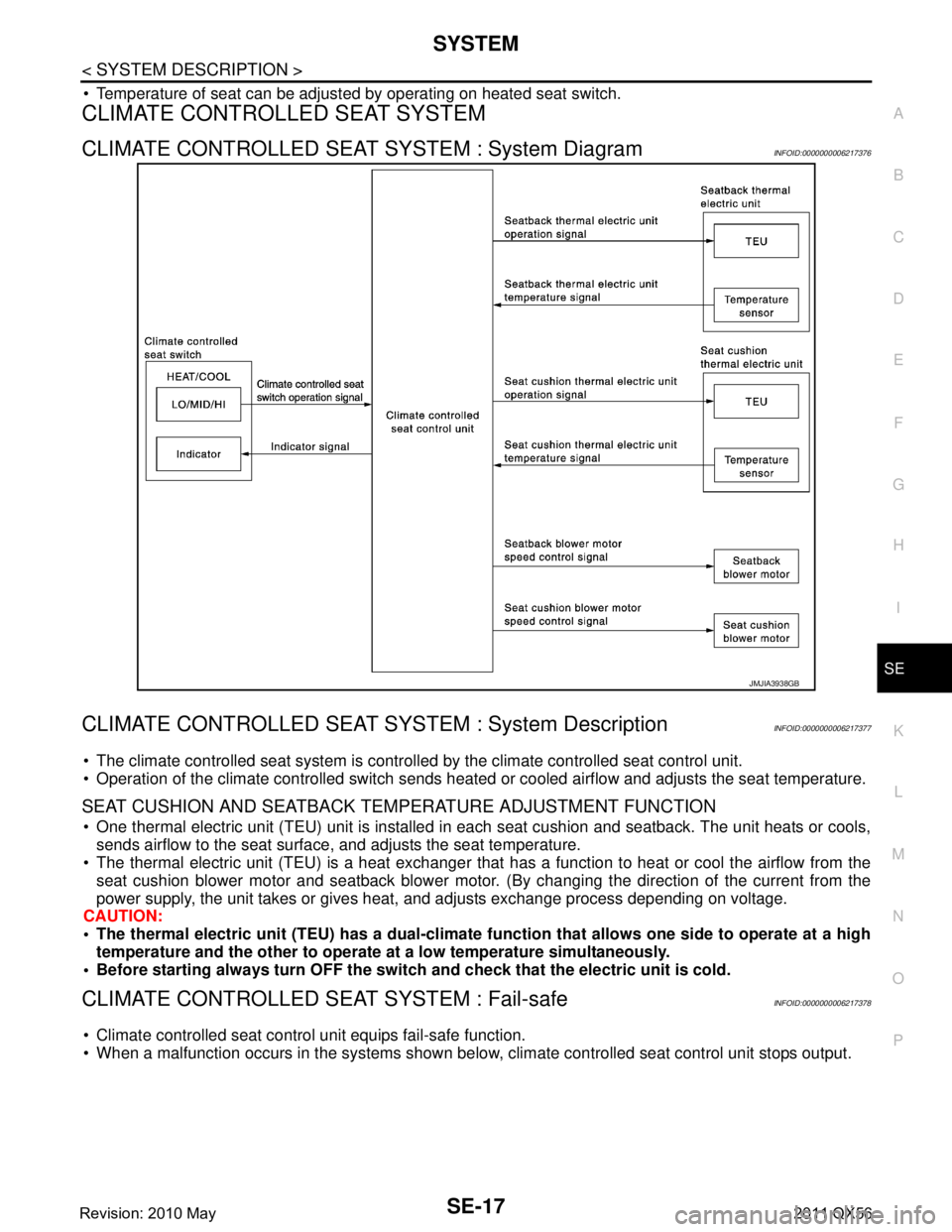2011 INFINITI QX56 stop start
[x] Cancel search: stop startPage 3883 of 5598
![INFINITI QX56 2011 Factory Service Manual
PCS-42
< SYSTEM DESCRIPTION >[POWER DISTRIBUTION SYSTEM]
DIAGNOSIS SYSTEM (BCM)
SELF-DIAG RESULT
Refer to
BCS-57, "DTCIndex".
DATA MONITOR
PW DOWN SET Unlock button pressing time on Intelligent Key INFINITI QX56 2011 Factory Service Manual
PCS-42
< SYSTEM DESCRIPTION >[POWER DISTRIBUTION SYSTEM]
DIAGNOSIS SYSTEM (BCM)
SELF-DIAG RESULT
Refer to
BCS-57, "DTCIndex".
DATA MONITOR
PW DOWN SET Unlock button pressing time on Intelligent Key](/manual-img/42/57033/w960_57033-3882.png)
PCS-42
< SYSTEM DESCRIPTION >[POWER DISTRIBUTION SYSTEM]
DIAGNOSIS SYSTEM (BCM)
SELF-DIAG RESULT
Refer to
BCS-57, "DTCIndex".
DATA MONITOR
PW DOWN SET Unlock button pressing time on Intelligent Key button can be selected from the following with
this mode
MODE 1: 3 sec
MODE 2: Non-operation
MODE 3: 5 sec
WELCOME LIGHT SELECT Welcome light function mode can be selected from the following with this mode
Puddle/Outside Handle
Room lamp
Head & Tail Lamps (this item is displayed, but cannot be used)
Heart Beat
WELCOME LIGHT OP SET Welcome light function mode can be changed to operation with this mode
On: Operate
Off: Non-operation
Monitor item Description
Monitor Item Condition
REQ SW -DR Indicates [On/Off] condition of door request switch (driver side)
REQ SW -AS Indicates [On/Off] condition of door request switch (passenger side)
REQ SW -BD/TR Indicates [On/Off] condition of back door request switch
PUSH SW Indicates [On/Off] condition of push-button ignition switch
CLUTCH SW NOTE:
This item is displayed, but cannot be monitored
BRAKE SW 1 Indicates [On/Off]* condition of stop lamp switch power supply
BRAKE SW 2 Indicates [On/Off] condition of stop lamp switch
DETE/CANCL SW Indicates [On/Off] condition of P position
SFT PN/N SW Indicates [On/Off] condition of P or N position
S/L -LOCK Indicates [On/Off] condition of steering lock unit (LOCK)
S/L -UNLOCK Indicates [On/Off] condition of steering lock unit (UNLOCK)
S/L RELAY -F/B Indicates [On/Off] condition of steering lock relay
UNLK SEN -DR Indicates [On/Off] condition of driver door UNLOCK status
PUSH SW -IPDM Indicates [On/Off] condition of push-button ignition switch
IGN RLY1 -F/B Indicates [On/Off] condition of ignition relay 1
DETE SW -IPDM Indicates [On/Off] condition of P position
SFT PN -IPDM Indicates [On/Off] condition of P or N position
SFT P -MET Indicates [On/Off] condition of P position
SFT N -MET Indicates [On/Off] condition of N position
ENGINE STATE Indicates [Stop/Stall/Crank/Run] condition of engine states
S/L LOCK-IPDM Indicates [On/Off] condition of steering lock unit (LOCK)
S/L UNLK-IPDM Indicates [On/Off] condition of steering lock unit (UNLOCK)
S/L RELAY-REQ Indicates [On/Off] condition of steering lock relay
VEH SPEED 1 Display the vehicle speed signal received from combination meter by numerical value [Km/h]
VEH SPEED 2 Display the vehi cle speed signal received from ABS or VDC or TCM by numerical value [Km/h]
DOOR STAT-DR Indicates [LOCK/READY/UNLK] condition of unlock sensor
DOOR STAT-AS Indicates [LOCK/READY/UNLK] condition of passenger side door status
ID OK FLAG Indicates [Set/Reset] condition of key ID
PRMT ENG STRT Indicates [Set/Reset] condition of engine start possibility
Revision: 2010 May2011 QX56
Page 4231 of 5598

INSPECTION AND ADJUSTMENTRF-17
< BASIC INSPECTION >
C
DE
F
G H
I
J
L
M A
B
RF
N
O P
INSPECTION AND ADJUSTMENT
ADDITIONAL SERVICE WHEN REPLACING CONTROL UNIT
ADDITIONAL SERVICE WHEN REPL ACING CONTROL UNIT : Description
INFOID:0000000006141230
MEMORY RESET PROCEDURE
1. Please observe the following instructi ons at confirming the sunroof operation.
NOTE:
Do not disconnect the electronic power while the sunroof is operating or within 5 seconds after the sunroof
stops (to wipe-out the memory of lid position and operating friction).
2. Initialization of system should be conducted after the following conditions.
When the sunroof motor is changed.
When the sunroof does not operate normally. (Incomplete initialization conditions)
ADDITIONAL SERVICE WHEN REPLACING CONTROL UNIT : Special Repair Re-
quirement
INFOID:0000000006141231
INITIALIZATION PROCEDURE
If the sunroof does not close or open automatically, us e the following procedure to return sunroof operation to
normal.
1. Press the tilt up switch and start the tilt up operation.
2. Release the tilt up switch once, press the tilt up switch again, press and hold the switch until lid pops up.
3. The glass lid moves slight toward tilt up direction then stop. (Press and hold the switch during this opera- tion)
4. Release the switch again, and press the tilt up s witch within the first 10 seconds. (Press and hold the
switch)
5. After 4 seconds, the glass lid will be automatically operated in sequence of tilt down, slide open and slide
close.
6. After the glass lid stops, release the switch 0.5 second later. (Press and hold the switch during this opera-
tion)
7. If slide switch operates normally, this initialization is done.
ANTI-PINCH FUNCTION
1. Full open the sunroof.
2. Place a wooden piece (wooden hammer handle, etc.) at near fully closed position.
3. Close the sunroof completely with auto-slide close.
Check that sunroof lowers for approximately 150 mm (5 .91in) or 2 seconds with out pinching a wooden piece
and stops.
CAUTION:
Never check with hands and other part of body because they may be pinched. Never get pinched.
Depending on environment and driving conditions, if a similar impact or lord is applied to the sun-
roof it may lower.
Check that auto-slide operates before inspect ion when system initialization is performed.
Perform initial setting when auto-slide operatio n or anti-pinch function does not operate normally.
Revision: 2010 May2011 QX56
Page 4242 of 5598

RF-28
< SYMPTOM DIAGNOSIS >
SQUEAK AND RATTLE TROUBLE DIAGNOSES
The following materials, not found in the kit, can also be used to repair squeaks and rattles.
UHMW (TEFLON) TAPE
Insulates where slight movement is present. Ideal for instrument panel applications.
SILICONE GREASE
Used in place of UHMW tape that is visible or does not fit. Only lasts a few months.
SILICONE SPRAY
Used when grease cannot be applied.
DUCT TAPE
Used to eliminate movement.
CONFIRM THE REPAIR
After repair is complete, test drive the vehicle to confir m that the cause of noise is repaired by test driving the
vehicle. Operate the vehicle under the same conditions as when the noise originally occurred. Refer to the
notes on the Diagnostic Worksheet.
Inspection ProcedureINFOID:0000000006367804
Refer to Table of Contents for specific component removal and installation information.
INSTRUMENT PANEL
Most incidents are caused by contact and movement between:
1. The cluster lid A and instrument panel
2. Acrylic lens and combination meter housing
3. Instrument panel to front pillar garnish
4. Instrument panel to windshield
5. Instrument panel mounting pins
6. Wiring harnesses behind the combination meter
7. A/C defroster duct and duct joint These incidents can usually be located by tapping or moving the components to duplicate the noise or by
pressing on the components while driving to stop the noise. Most of these incidents can be repaired by
applying felt cloth tape or silicon spray (in hard to reach areas). Urethane pads can be used to insulate
wiring harness.
CAUTION:
Never use silicone spray to isolate a squeak or ra ttle. If the area is saturated with silicone, the
recheck of repair becomes impossible.
CENTER CONSOLE
Components to check include:
1. Shifter assembly cover to finisher
2. A/C control unit and cluster lid C
3. Wiring harnesses behind audio and A/C control unit
The instrument panel repair and isolation pr ocedures also apply to the center console.
DOORS
Check the following items:
1. Finisher and inner panel making a slapping noise
2. Inside handle escutcheon connection to door finisher
3. Wiring harnesses tapping
4. Door striker out of alignment causing a popping noise on starts and stops
Tapping, moving the components, or pressing on them wh ile driving to duplicate the conditions can isolate
many of these incidents. The areas can usually be insula ted with felt cloth tape or insulator foam blocks from
the NISSAN Squeak and Rattle Kit (J-43980) to repair the noise.
TRUNK
Trunk noises are often caused by a loose jack or loose items put into the trunk by the customer.
In addition check for the following items:
1. Trunk lid dumpers out of adjustment
2. Trunk lid striker out of adjustment
Revision: 2010 May2011 QX56
Page 4305 of 5598

SBC-8
< SYSTEM DESCRIPTION >
SYSTEM
When the vehicle inclined excessively
When comfort function operates
OPERATION CONDITION
Operation while driving
Operation start and stop conditions of pre-crash seat belt system are as shown in the following table.
The activation and deactivation conditions of pre-crush seat belt are as per the following.
NOTE:
For details of intelligent brake assist system.Refer to BRC-152, "
INTELLIGENT BRAKE ASSIST : System
Description".
Comfort function
Seat belt is retracted and the looseness is reduced in the state as shown in the following table.
Operation start and stop conditions of pre-crash seat belt system are as shown in the following table.
Operation Prohibition Condition
Pre-crash seat belt system does not operate in the following conditions.
When seat belt is not fastened (only the seat belt that is not fastened does not operate)
When motor is overheat due to contentious operation*1
When the system is in fail-safe mode *1: System operation is temporarily deactivated to av oid overheating, when comfort function is continuously
operated (18 times or more) during a short period of time by fastening and unfastening seat belts or opening
and closing doors.
MALFUNCTION WARNING
When system malfunction is detected, comfort function is deactivated to warn customer of system malfunc-
tion.
Operation item Operation start condition Operation stop condition
During emergency brake operation Vehicle speed is 15 km/h (9 MPH) or more
Emergency braking status is detected
During acceleration
When stopped
When ABS continuously operates ABS continuously operates for 2 seconds or
more
Brake pedal is in depressed state
When intelligent brake assistance oper-
ates System detects that intelligent brake assistance is
in operating status
2 seconds after operation start
When lateral slippage during cornering
occurs Vehicle speed is 30 km/h (19 MPH) or more
System detects that the vehicle is in lateral slip-
page state
System detects that the vehicle is driving on a curve Vehicle stopped
1 second or more after maintaining
steering wheel angle in straight driv-
ing state
When steering wheel is rotated for emer-
gency Vehicle speed is 60 km/h (36 MPH) or more
Steering wheel angle is 90 degrees or more
System detects that steering wheel is rotated for
emergency
When the vehicle inclined excessively Vehicle speed is 30 km/h (19 MPH) or more
System detects that the vehicle inclined exces-
sively During acceleration
Vehicle stopped
Operation item Activating condition Deactivating condition
Door open Seat belt is in not fastened state
Door is operated to open from closed
Vehicle stopped Seat belt retract is complete
13 seconds after start retracting
Seat belt is fastened When door is closed
Seat belt is fastened Seat belt is unfastened
1 second after operation
Seat belt is release Seat belt is unfastened Seat belt retract is complete
10 seconds after start retracting
Revision: 2010 May2011 QX56
Page 4389 of 5598
![INFINITI QX56 2011 Factory Service Manual
DIFFERENCE IN APPEARANCESCS-29
< SYMPTOM DIAGNOSIS > [HBMC]
C
D
F
G H
I
J
K L
M A
B
SCS
N
O P
SYMPTOM DIAGNOSIS
DIFFERENCE IN APPEARANCE
DescriptionINFOID:0000000006256016
While the vehicle is stoppe INFINITI QX56 2011 Factory Service Manual
DIFFERENCE IN APPEARANCESCS-29
< SYMPTOM DIAGNOSIS > [HBMC]
C
D
F
G H
I
J
K L
M A
B
SCS
N
O P
SYMPTOM DIAGNOSIS
DIFFERENCE IN APPEARANCE
DescriptionINFOID:0000000006256016
While the vehicle is stoppe](/manual-img/42/57033/w960_57033-4388.png)
DIFFERENCE IN APPEARANCESCS-29
< SYMPTOM DIAGNOSIS > [HBMC]
C
D
F
G H
I
J
K L
M A
B
SCS
N
O P
SYMPTOM DIAGNOSIS
DIFFERENCE IN APPEARANCE
DescriptionINFOID:0000000006256016
While the vehicle is stopped, the difference of vehicle height of right side and left side (between wheel center
and wheel arch) is 25 mm (0.98 in) or more.
Inspection ProcedureINFOID:0000000006256017
1.CHECK APPEARANCE
1. Visually check that the exterior parts (e.g. suspension spring) have no malfunctions.
2. Visually check tube and pipe for crush or oil leakage.
Is the check result normal?
YES >> GO TO 2.
NO >> Repair or replace damaged parts.
2.CHECK CLOGGING OF ORIFICE IN PPMU
1. Install an oil pressure gauge (SST: KV40108000) (A) to oil injec- tion jack.
CAUTION:
Clean surrounding areas of oi l injection jack using steam
before starting oper ation, since there may be mud on it.
Clean oil pressure gauge (special service tool:
KV40108000) jack with steam before use.
Jack must be securely inserted until a click sound can be heard.
Pressure reducing valve (B) of the oil pressure gauge
must be closed.
2. Loosen needle valves A and C of PPMU by approximately 2 rotations for check changes in vehicle height.
CAUTION:
Never loosen the needle valve more than required.
3. Tighten needle valve A and C of PPMU to the specified torque after the inspection.
Does the vehicle height change 10 mm (0.39 in) or more?
YES >> For detailed inspection of clogging of orifice in PPMU, refer to SCS-27, "
Work Procedure".
NO >> INSPECTION END
JSEIA0186ZZ
Tightening torque : 8.3 N· m (0.85 kg-m, 73 in-lb)
JSEIA0187ZZ
Revision: 2010 May2011 QX56
Page 4415 of 5598
![INFINITI QX56 2011 Factory Service Manual
SYSTEMSCS-55
< SYSTEM DESCRIPTION > [AIR LEVELIZER CONTROL SYSTEM]
C
D
F
G H
I
J
K L
M A
B
SCS
N
O P
Vehicle height raises [When starting engi
ne, if vehicle height of vehicle rear continues for 30 s INFINITI QX56 2011 Factory Service Manual
SYSTEMSCS-55
< SYSTEM DESCRIPTION > [AIR LEVELIZER CONTROL SYSTEM]
C
D
F
G H
I
J
K L
M A
B
SCS
N
O P
Vehicle height raises [When starting engi
ne, if vehicle height of vehicle rear continues for 30 s](/manual-img/42/57033/w960_57033-4414.png)
SYSTEMSCS-55
< SYSTEM DESCRIPTION > [AIR LEVELIZER CONTROL SYSTEM]
C
D
F
G H
I
J
K L
M A
B
SCS
N
O P
Vehicle height raises [When starting engi
ne, if vehicle height of vehicle rear continues for 30 seconds or more in a
status that is 15 mm (0.59 in) or less than standard vehicle height]
1. Vehicle height sensor detects vehicle height status, and transmits this information to air levelizer control
module.
2. Air levelizer control module turns air compressor relay ON and operates air compressor.
3. Air compressor charges air in air chamber of shock absorber.
4. Vehicle height raises, and control is complete when status is −1 mm ( −0.04 in) of standard vehicle height
value.
Vehicle height lowers [When starting engine, if vehicle height of vehicle rear continues for 30 seconds or more in a
status that is 15 mm (0.59 in) or more of standard vehicle height]
1. Vehicle height sensor detects vehicle height status, and transmits this information to air levelizer control
module.
2. Air levelizer control module turns exhaust solenoid of air compressor ON.
3. Air compressor discharges air from air chamber of shock absorber.
4. Vehicle height lowers, and control is complete when st atus is +1 mm (+0.04 in) of standard vehicle height.
Fail-safeINFOID:0000000006256051
If malfunction is detected, control stops.
The system may enter fail-safe mode under certain conditions (for example, over-laden conditions) when elec-
tronic circuit is normal.
In this case, always check that the system re turns to normal by starting engine after unloading load.
JSEIA0221GB
Revision: 2010 May2011 QX56
Page 4419 of 5598
![INFINITI QX56 2011 Factory Service Manual
AIR LEVELIZER CONTROL MODULESCS-59
< ECU DIAGNOSIS INFORMATION > [AIR LEVELIZER CONTROL SYSTEM]
C
D
F
G H
I
J
K L
M A
B
SCS
N
O P
Fail-safeINFOID:0000000006256054
If malfunction is detected, control INFINITI QX56 2011 Factory Service Manual
AIR LEVELIZER CONTROL MODULESCS-59
< ECU DIAGNOSIS INFORMATION > [AIR LEVELIZER CONTROL SYSTEM]
C
D
F
G H
I
J
K L
M A
B
SCS
N
O P
Fail-safeINFOID:0000000006256054
If malfunction is detected, control](/manual-img/42/57033/w960_57033-4418.png)
AIR LEVELIZER CONTROL MODULESCS-59
< ECU DIAGNOSIS INFORMATION > [AIR LEVELIZER CONTROL SYSTEM]
C
D
F
G H
I
J
K L
M A
B
SCS
N
O P
Fail-safeINFOID:0000000006256054
If malfunction is detected, control stops.
The system may enter fail-safe mode under certain condi tions (for example, over-laden conditions) when elec-
tronic circuit is normal.
In this case, always check that the system re turns to normal by starting engine after unloading load.
DTC Inspection Priority ChartINFOID:0000000006256055
If some DTCs are displayed at the same time, per form inspections one by one based on the following priority
chart.
DTC IndexINFOID:0000000006256056
5
(W) Ground Vehicle height sensor
(SIGNAL) InputIGN ON 0.2 – 4.6 V
IGN OFF 0 V
7
(P) 16
(L) CAN-L
Input/
Output — 54 – 69
Ω
9
(P/L) Ground Air levelizer co
ntrol module
power supply InputIGN ON 10 – 16 V
IGN OFF 0 V
11
(V/W) Ground Exhaust solenoid Output IGN ON Exhaust solenoid: ON 9 – 16 V
Exhaust solenoid: OFF Less than 2 V
13
(R) Ground Vehicle height sensor
(Power supply)
OutputIGN ON 4.5 – 5.5 V
IGN OFF 0 V
16
(L) 7
(P) CAN-H Input/
Output — 54 – 69
Ω
Te r m i n a l
(Wire color) Description
ConditionReference value
(Approx.)
+ − Signal name Input/
Output
Priority Detected items (DTC)
1 U1000 CAN COMM CIRCUIT
U1010 CONTROL UNIT (CAN)
2 C1801 VHCL HEIGHT SENSOR
C1802 AIR SUS COMPRS RELAY
C1803 AIR SUS EXH SOL
C1806 VHCL HEIGHT SEN FIX
C1807 VHCL HEIGHT SEN VOLT
3 C1804 VHCL HEIGHT ADJ UP
C1805 VHCL HEIGHT ADJ DOWN
C1808 AIR SUS COMPRS FNCTN
DTC CONSULT-III display Reference page
C1801 VHCL HEIGHT SENSOR SCS-69
C1802 AIR SUS COMPRS RELAYSCS-72
C1803 AIR SUS EXH SOLSCS-74
C1804 VHCL HEIGHT ADJ UPSCS-77
C1805 VHCL HEIGHT ADJ DOWNSCS-80
C1806 VHCL HEIGHT SEN FIXSCS-81
C1807 VHCL HEIGHT SEN VOLTSCS-82
C1808 AIR SUS COMPRS FNCTNSCS-84
Revision: 2010 May2011 QX56
Page 4476 of 5598

SYSTEMSE-17
< SYSTEM DESCRIPTION >
C
DE
F
G H
I
K L
M A
B
SE
N
O P
Temperature of seat can be adjust ed by operating on heated seat switch.
CLIMATE CONTROLLED SEAT SYSTEM
CLIMATE CONTROLLED SEAT SYSTEM : System DiagramINFOID:0000000006217376
CLIMATE CONTROLLED SEAT S YSTEM : System DescriptionINFOID:0000000006217377
The climate controlled seat system is controll ed by the climate controlled seat control unit.
Operation of the climate controlled switch sends heat ed or cooled airflow and adjusts the seat temperature.
SEAT CUSHION AND SEATBACK TEMPERATURE ADJUSTMENT FUNCTION
One thermal electric unit (TEU) unit is installed in each seat cushion and seatback. The unit heats or cools,
sends airflow to the seat surface, and adjusts the seat temperature.
The thermal electric unit (TEU) is a heat exchanger that has a function to heat or cool the airflow from the
seat cushion blower motor and seatback blower motor. (By changing the direction of the current from the
power supply, the unit takes or gives heat, and adjusts exchange process depending on voltage.
CAUTION:
The thermal electric unit (TEU) has a dual-climate fu nction that allows one side to operate at a high
temperature and the other to operate at a low temperature simultaneously.
Before starting always turn OFF the switch and check that the electric unit is cold.
CLIMATE CONTROLLED SEAT SYSTEM : Fail-safeINFOID:0000000006217378
Climate controlled seat control unit equips fail-safe function.
When a malfunction occurs in the systems shown below , climate controlled seat control unit stops output.
JMJIA3938GB
Revision: 2010 May2011 QX56